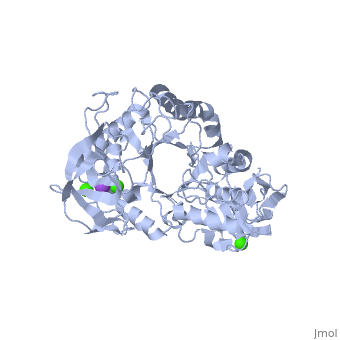1hvx: Difference between revisions
New page: left|200px<br /><applet load="1hvx" size="450" color="white" frame="true" align="right" spinBox="true" caption="1hvx, resolution 2.0Å" /> '''BACILLUS STEAROTHERMO... |
No edit summary |
||
| Line 1: | Line 1: | ||
[[Image:1hvx.gif|left|200px]]<br /><applet load="1hvx" size=" | [[Image:1hvx.gif|left|200px]]<br /><applet load="1hvx" size="350" color="white" frame="true" align="right" spinBox="true" | ||
caption="1hvx, resolution 2.0Å" /> | caption="1hvx, resolution 2.0Å" /> | ||
'''BACILLUS STEAROTHERMOPHILUS ALPHA-AMYLASE'''<br /> | '''BACILLUS STEAROTHERMOPHILUS ALPHA-AMYLASE'''<br /> | ||
==Overview== | ==Overview== | ||
The crystal structure of a thermostable alpha-amylase from Bacillus | The crystal structure of a thermostable alpha-amylase from Bacillus stearothermophilus (BSTA) has been determined at 2.0 A resolution. The main-chain fold is almost identical to that of the known crystal structure of Bacillus licheniformis alpha-amylase (BLA). BLA is known to be more stable than BSTA. A structural comparison between the crystal structures of BSTA and BLA showed significant differences that may account for the difference in their thermostabilities, as follows. (i) The two-residue insertion in BSTA, Ile181-Gly182, pushes away the spatially contacting region including Asp207, which corresponds to Ca(2+)-coordinating Asp204 in BLA. As a result, Asp207 cannot coordinate the Ca(2+). (ii) BSTA contains nine fewer hydrogen bonds than BLA, which costs about 12 kcal/mol. This tendency is prominent in the (beta/alpha)(8)-barrel, where 10 fewer hydrogen bonds were observed in BSTA. BLA forms a denser hydrogen bond network in the inter-helical region, which may stabilize alpha-helices in the barrel. (iii) A few small voids observed in the alpha-helical region of the (beta/alpha)(8)-barrel in BSTA decrease inter-helical compactness and hydrophobic interactions. (iv) The solvent-accessible surface area of charged residues in BLA is about two times larger than that in BSTA. | ||
==About this Structure== | ==About this Structure== | ||
1HVX is a [http://en.wikipedia.org/wiki/Single_protein Single protein] structure of sequence from [http://en.wikipedia.org/wiki/Geobacillus_stearothermophilus Geobacillus stearothermophilus] with CA and NA as [http://en.wikipedia.org/wiki/ligands ligands]. Active as [http://en.wikipedia.org/wiki/Alpha-amylase Alpha-amylase], with EC number [http://www.brenda-enzymes.info/php/result_flat.php4?ecno=3.2.1.1 3.2.1.1] Full crystallographic information is available from [http:// | 1HVX is a [http://en.wikipedia.org/wiki/Single_protein Single protein] structure of sequence from [http://en.wikipedia.org/wiki/Geobacillus_stearothermophilus Geobacillus stearothermophilus] with <scene name='pdbligand=CA:'>CA</scene> and <scene name='pdbligand=NA:'>NA</scene> as [http://en.wikipedia.org/wiki/ligands ligands]. Active as [http://en.wikipedia.org/wiki/Alpha-amylase Alpha-amylase], with EC number [http://www.brenda-enzymes.info/php/result_flat.php4?ecno=3.2.1.1 3.2.1.1] Full crystallographic information is available from [http://oca.weizmann.ac.il/oca-bin/ocashort?id=1HVX OCA]. | ||
==Reference== | ==Reference== | ||
Crystal structure of Bacillus stearothermophilus alpha-amylase: possible factors determining the thermostability., Suvd D, Fujimoto Z, Takase K, Matsumura M, Mizuno H, J Biochem | Crystal structure of Bacillus stearothermophilus alpha-amylase: possible factors determining the thermostability., Suvd D, Fujimoto Z, Takase K, Matsumura M, Mizuno H, J Biochem. 2001 Mar;129(3):461-8. PMID:[http://ispc.weizmann.ac.il//pmbin/getpm?pmid=11226887 11226887] | ||
[[Category: Alpha-amylase]] | [[Category: Alpha-amylase]] | ||
[[Category: Geobacillus stearothermophilus]] | [[Category: Geobacillus stearothermophilus]] | ||
| Line 31: | Line 31: | ||
[[Category: thermostability]] | [[Category: thermostability]] | ||
''Page seeded by [http:// | ''Page seeded by [http://oca.weizmann.ac.il/oca OCA ] on Thu Feb 21 13:05:32 2008'' | ||
Revision as of 14:05, 21 February 2008
|
BACILLUS STEAROTHERMOPHILUS ALPHA-AMYLASE
OverviewOverview
The crystal structure of a thermostable alpha-amylase from Bacillus stearothermophilus (BSTA) has been determined at 2.0 A resolution. The main-chain fold is almost identical to that of the known crystal structure of Bacillus licheniformis alpha-amylase (BLA). BLA is known to be more stable than BSTA. A structural comparison between the crystal structures of BSTA and BLA showed significant differences that may account for the difference in their thermostabilities, as follows. (i) The two-residue insertion in BSTA, Ile181-Gly182, pushes away the spatially contacting region including Asp207, which corresponds to Ca(2+)-coordinating Asp204 in BLA. As a result, Asp207 cannot coordinate the Ca(2+). (ii) BSTA contains nine fewer hydrogen bonds than BLA, which costs about 12 kcal/mol. This tendency is prominent in the (beta/alpha)(8)-barrel, where 10 fewer hydrogen bonds were observed in BSTA. BLA forms a denser hydrogen bond network in the inter-helical region, which may stabilize alpha-helices in the barrel. (iii) A few small voids observed in the alpha-helical region of the (beta/alpha)(8)-barrel in BSTA decrease inter-helical compactness and hydrophobic interactions. (iv) The solvent-accessible surface area of charged residues in BLA is about two times larger than that in BSTA.
About this StructureAbout this Structure
1HVX is a Single protein structure of sequence from Geobacillus stearothermophilus with and as ligands. Active as Alpha-amylase, with EC number 3.2.1.1 Full crystallographic information is available from OCA.
ReferenceReference
Crystal structure of Bacillus stearothermophilus alpha-amylase: possible factors determining the thermostability., Suvd D, Fujimoto Z, Takase K, Matsumura M, Mizuno H, J Biochem. 2001 Mar;129(3):461-8. PMID:11226887
Page seeded by OCA on Thu Feb 21 13:05:32 2008
